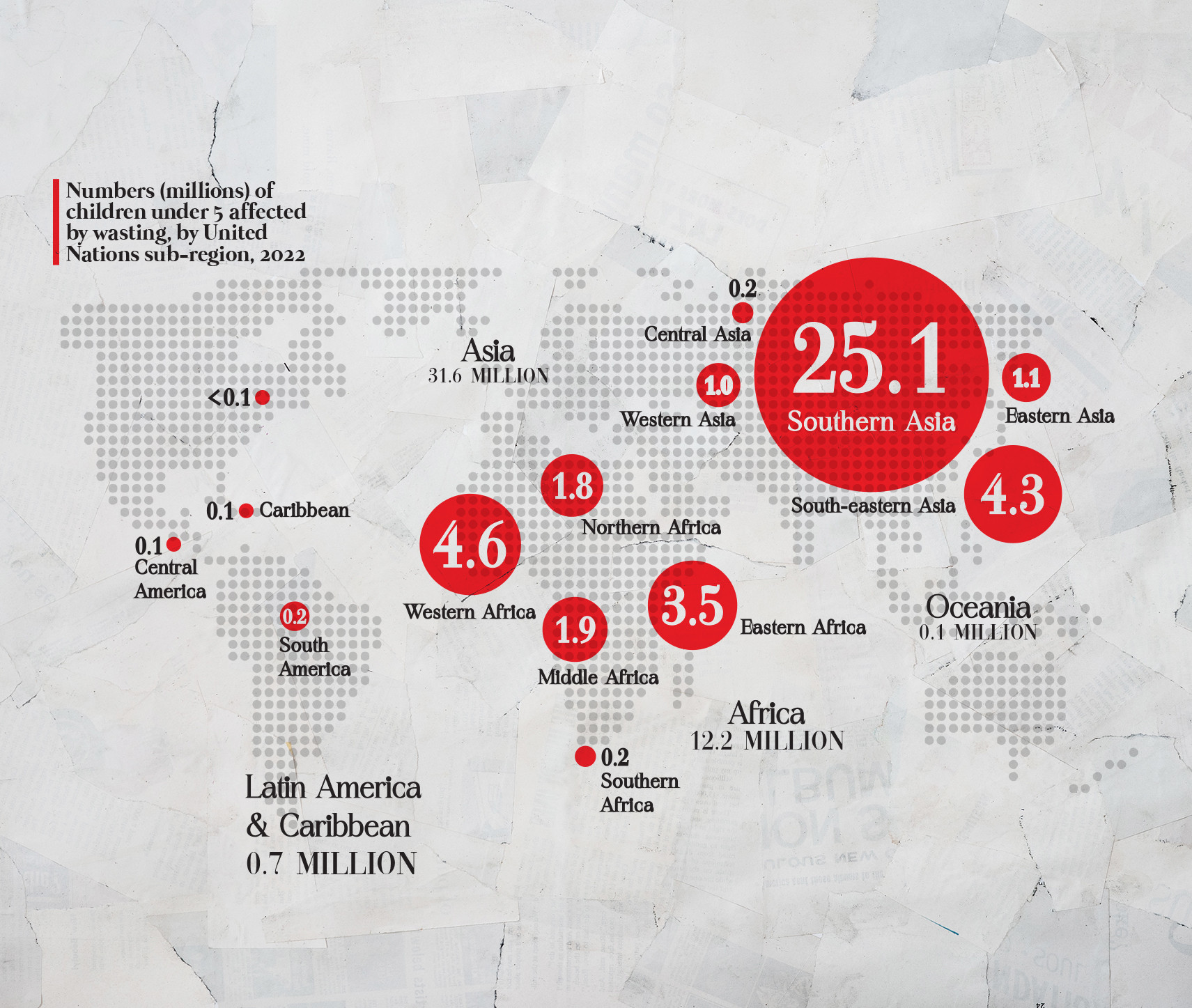A NATION STARVES, AN ECONOMY SUFFERS
Malnutrition, driven by factors like poverty and inflation, hinders economic growth and human potential in Pakistan
At the heart of any country's pursuit of progress lies the well-being of its people. Yet, an insidious foe silently erodes this foundation: malnutrition. This quiet crisis, manifested in the hollow cheeks of children and the wearied eyes of parents, not only steals away vitality but also stifles a nation's economic growth potential. Malnutrition, a complex adversary encompassing undernutrition, micronutrient deficiencies, and obesity, is more than a health issue—it is a key determinant of a country's development trajectory.
In bustling cities and remote villages alike, the impact of malnutrition creeps in. Children grappling with stunted growth and compromised cognitive development face an uphill battle to break free from the shackles of poverty. Mothers confront the challenges of providing nourishment for their families amidst scarce resources. It is in these stories of struggle and resilience that the profound connection between malnutrition and economic growth emerges.
Economic growth, often measured in numbers and percentages, is reflected in the lives of individuals. Malnutrition robs communities of their potential, clouding their futures, and perpetuates a cycle of deprivation. The intricate relationship between malnutrition and economic growth demands holistic interventions on an urgent basis, where both health and prosperity intertwine, forging a path toward a brighter future for all citizens.
Malnutrition in Pakistan
Pakistan has been grappling with this formidable public health challenge. Malnutrition is a multifaceted issue which encompasses not only undernutrition—characterised by stunting, wasting, and underweight conditions—but also overnutrition, linked to obesity and diet-related non-communicable diseases.
The intricate web of factors contributing to the prevalence of malnutrition in Pakistan is underscored by a confluence of socio-economic and cultural dynamics.
Poverty is a primary catalyst for malnutrition, affecting approximately a quarter of the population who is unable to afford sufficient nourishment. Moreover, food insecurity, aggravated by natural disasters, conflict, and insecurity, disrupts access to sustenance even for those above the poverty line.
Inadequate breastfeeding practices further compound the issue. Despite the recognised benefits, exclusive breastfeeding for the first six months of an infant's life remains a challenge due to various factors. Poor sanitation and hygiene conditions also play a significant role, increasing the vulnerability to diarrheal diseases that amplify malnutrition risks. Alarmingly, improved sanitation facilities and clean drinking water remain inaccessible for a substantial portion of the population. Unhealthy dietary habits, marked by a lack of nutritious foods like fruits and vegetables, contribute to the malnutrition crisis, particularly impacting children. Adding to the complexity is the lack of awareness about the vital role of proper nutrition, leading to suboptimal dietary choices.
The new challenge is the increasing inflation in the country that affects the accessibility, cost, and availability of food in various ways. The main connection between inflation and malnutrition is accessibility; food costs generally increase as a result of inflation. When food prices rise, families with limited resources may find it difficult to afford nourishing foods, which can compromise dietary choices. Because of this, there may be a decreased intake of vital nutrients, which can lead to different types of malnutrition.
The interplay of these factors highlights the urgency of addressing malnutrition in Pakistan comprehensively. The undercurrents of poverty, inadequate healthcare, and cultural norms intertwine to create a perfect storm of persistent malnutrition. To break this cycle, concerted efforts are needed not only to provide immediate food assistance but also to foster awareness, improve healthcare infrastructure, and promote practices that prioritise nutrition. By addressing these underlying issues, Pakistan can make strides towards a healthier and more prosperous future free of malnutrition.
Tracing malnutrition's multi-faceted causes
The central impact revolves around the ability to purchase nutrient-rich food, as purchasing power diminishes with unwavering inflation. High food prices leave individuals and families grappling with compromised dietary choices. Households compelled by the rising cost of living often find themselves slashing food expenditures. This budgetary strain can drive the selection of more affordable, calorie-dense alternatives which unfortunately lack essential nutrients. A ripple effect unfolds—micronutrient deficiencies and the spectre of overnutrition, embodied by obesity, emerge.
Economist Dr Kaiser Bengali underscores the direct link between malnutrition and inflation. “Malnutrition is directly linked to inflation and there is no other way for it because people cut off fruits, nuts, dairy, and other items in their food when prices increase as they think having wheat in the form of ‘chapati’ is enough for them because they are unable to afford other items,” explained Dr Bengali, adding that the main idea is to fill their stomach with minimal food rather than consuming protein, dairy, and other nutrients.
One of the primary contributors to childhood malnutrition, resulting in stunted growth, is insufficient maternal nutrition during pregnancy. Stunting has a profound impact, affecting around 10 million children in Pakistan. Sadly, only 38% of infants are exclusively breastfed during the initial six months of their lives. This issue isn't a sudden development, as the country has been grappling with healthcare challenges for quite some time. However, the recent surge in prices has exacerbated the situation, bringing this long-standing problem to the forefront.
"It's like a slow poison that has been infiltrating society for a considerable duration,” Dr Bengali said. “Historical instances in places like Tharparkar have demonstrated how undernourished women give birth to malnourished babies. I have personally witnessed cases where newborns weighed merely one kg birth. One can only imagine the dire circumstances the mother must have endured throughout her pregnancy — scarce nourishment and minimal postnatal care. It's truly a lamentable situation," he expressed with concern.
Ripple effects of nutritional deficiency
Much as food scarcity or limited food options can hinder a child's growth, deficiency of proper nutrition doesn't just impact weight and physical well-being, it also affects intelligence, skills, mental capacity, and physical activities. Dr. Bengali emphasised, "It's not only maternal malnutrition during pregnancy that contributes to childhood malnutrition, but also the quality of nutrition provided to children later on. In underprivileged areas with limited resources, caregivers often have no choice but to feed their children diluted milk due to lack of alternatives."
Children who are undernourished from birth or during their early years, failing to receive the necessary nutrients for their bodies and minds to function adequately, may grow up to be weak adults, both intellectually and physically. Dr. Bengali added, "Historical trends in sports performance illustrate this connection. The success or decline in various sports isn't solely determined by training methods. The nutrition players receive during those times also plays a pivotal role. For instance, the rise and fall of hockey in our country can be attributed not just to the training but also to the nutritional intake during those periods."
A noteworthy example can be seen in China where basketball was once unimaginable due to the population's low average height. However, with sustained access to nutritional food and supplements, basketball has flourished, and the country's average height has increased. Dr. Bengali highlighted, "Nutrition has a transformative impact on physical attributes and capabilities."
Malnutrition, particularly during critical brain development phases like pregnancy and early childhood, can result in stunted brain growth. Brain tissue growth and overall expansion rely heavily on proper nutrition, encompassing essential components like proteins, lipids, vitamins, and minerals. An economist pointed out, "When the body lacks essential components, the brain's capacity is also compromised. The escalating inflation poses a grim outlook for future generations in terms of intelligence and capabilities."
Deficiencies in vital nutrients such as iron, iodine, zinc, vitamin A, and omega-3 fatty acids can lead to cognitive deficits in children. These nutrients are crucial for effective brain communication, and their absence can manifest as challenges in learning, problem-solving, memory, and attention.
Squeezed budgets and silent hunger
According to the World Food Programme, malnutrition incurs a yearly cost of $7.6 billion for Pakistan, equivalent to roughly three percent of its GDP. While visible malnutrition is concerning, a more significant impact occurs within middle-class households. Inflation forces people to reduce their food choices to essentials like rice and flour, cutting out items like fruits, nuts, and dairy products. Today, even someone earning 50,000 rupees monthly for a family of four can barely afford basic sustenance. Escalating bills and food expenses are gradually eroding the intellectual fabric of society.
A primary cause of stunted growth in children is inadequate maternal nutrition during pregnancy. Stunting affects around 10 million children in Pakistan, and merely 38 percent of infants are exclusively breastfed in their first six months of life.
Hafeezullah Gambhir, the provincial program manager in Sindh for Nutrition International, said that poverty is the sole reason for malnutrition. "All other factors are secondary in this race," he told
Express Tribune. Picking up a handful of nuts from his table, Gambhir remarked that middle-class individuals and average Pakistanis can no longer afford this luxury. Regrettably, the escalating inflation and the resulting dire circumstances seem unstoppable.
Nourishing solutions amidst economic constraints
The financial crunch cannot be controlled and will only make eating healthy food a far-fetched dream for people in the coming days. The easiest solution right now is for Pakistan to move toward fortified flour, oil, and rice so the nutrients that are lacking can be provided to those who are unable to afford a nutrient-rich diet.
For example, the most consumed food and easily available is flour. People eat flour in the shape of bread and roti, so fortifying flour will help in the long run. “The cost of fortifying flour is in pennies and would hardly increase the selling cost by 50 paisas but the mills association aren’t willing to bear the cost while the government organisations do not have the will to step in and take initiative for this,” Gambhir said. “The pre-mix that has Vitamin B12, iron and folic acid costs 2,400-3,000 rupees per kilogramme which can be mixed in 5,000 kg of flour and it’ll be fortified. The machines and mechanism are already there and the mills are being provided with the machines as well but still none of the authorities are serious about the work.”
Similarly, two decades ago no one thought that iodized salty would be used in every household as it is used now. It took decades for people to realize its benefits. “Fortified flour will also take five to 10 years even if the government starts implementing the law today,” Gambhir said. “Many conspiracy theories also form around such initiatives. One such theory and media coverage can easily push the idea three to five years back. The whole effort goes in vain with only one silly comment from any authority,” the program manager explained.
Awareness and education on a larger scale are required to save people from this epidemic in the making. In the next decade or two, Pakistani children who aren’t consuming nutrients and necessary vitamins will be very visibly undernourished as compared to neighbouring countries. If the youngsters won't be able to compete in the economy, we must consider where Pakistan will end up.
As of now Sunridge is the only flour mill which is making and selling fortified flour and selling it across Pakistan, giving it a monopoly over the prices. The reason flour mill owners don’t take a step forward is their fear that people will not buy flour if they find even a 50 paisa increase in per kg cost. This is where the role of the government comes in, as to where they are giving subsidy to the flour mills. For example, if the cost of one bag of 40 kg of flour costs 4,000 rupees, the government gives a subsidy of 2,500 rupees. Similarly, it can add 50 paisa to that cost and consumers can get more nutrients in their food.
“The solution is not 100 per cent but it is far better than just having people not consume nutrients at all. As someone who is not able to afford fruits, nuts, or dairy in daily life, a person cannot even afford multivitamins for themselves,” added Gambhir.
Malnourished children are more likely to encounter behavioural problems including anxiety, sadness, and attention-deficit/hyperactivity disorder (ADHD). This is related to both the stress brought on by a life of hardship and food deprivation as well as the direct effects on brain chemistry.
Severe malnutrition, particularly in the early years of life, can permanently alter the structure and function of the brain. Even if a person's nutritional health improves later in life, this may still have an impact on their intellectual and cognitive ability. Other than that, children who are undernourished frequently suffer in school because they have trouble focusing, remembering, and learning. Poor academic achievement and few possibilities for future success may be the outcome of these difficulties.
“Such children are just lagging behind in every way and it's not even their fault. The situation of affordability and purchasing power is getting worse day by day. Given the condition, it will not get better anytime soon,” Gambhir said sadly.
The role of international bodies
The year 1990 was a turning point in the global commitment to eradicate micronutrient deficiencies, when world leaders convened at the World Summit for Children. Canada established the Micronutrient Initiative in 1992 to address micronutrient malnutrition and pave the way for a healthier world. This initiative transformed into Nutrition International (NI) in 2017, expanding its impact to over 60 countries, including Pakistan, where NI has taken an active role in the fight against malnutrition.
In Pakistan since 2001, NI has been working to enhance the health of vulnerable populations, focusing on women and children. Through partnerships with the Government of Pakistan, NI has played a pivotal role in advancing various nutrition-related initiatives across the country.
NI's efforts encompass a range of activities aimed at improving nutritional outcomes. From enhancing vitamin A supplementation for children under five to promoting zinc supplements and oral rehydration salts for managing childhood diarrhoea, NI's interventions touch multiple facets of health. Furthermore, NI extends its reach to remote rural areas, ensuring that marginalised groups receive improved nutrition and healthcare services.
Working in tandem with national and provincial government departments, NI has been instrumental in fortifying wheat flour to reach millions of people and improving levels of iron, vitamin B12, and folic acid among children and women.
One noteworthy accomplishment is NI's involvement in the Sindh Food Fortification Act 2021. This groundbreaking legislation makes Sindh the first province in Pakistan to enact a law focused on food fortification. NI played a significant role in the drafting of this bill, showcasing its dedication to addressing malnutrition at a policy level.
Between 2016 and 2020, NI concentrated on building technical and human resource capacity, collaborating with government departments, and strengthening industry associations. This holistic approach not only enhances knowledge but also fosters sustainable change.
In Pakistan, where malnutrition remains a persistent challenge, NI's efforts stand as a testament to the power of collective action. By working hand in hand with governments, communities, and industry stakeholders, NI seeks to contribute to a healthier, more nourished future for all, embodying the spirit of collaboration and impact-driven change.
Need of the hour
The need of the hour is a strategic approach that encompasses both immediate relief and sustainable solutions to effectively address the nexus between inflation and malnutrition. Such a strategy should encompass implementing policies that not only regulate food prices but also ensure food security for vulnerable populations. It should also incorporate targeted social safety nets, subsidies for essential commodities, support for local food production, promotion of agricultural efficiency, and facilitation of local food systems.
Gambhir highlighted the potential agents of change in this scenario. "The key players who can bring about a transformation by introducing fortified flour or other nutritional items to the public include the traditional bureaucratic establishment, the association of flour mills, and the media," he said. He fexplained that this requires a substantial scale of advocacy. The involvement of organisations like the Asian Bank and USAID could swiftly propel implementation. However, these approaches often remain unheard and overlooked in favour of established ideologies and research. Gambhir emphasised, "Creating awareness, advocating for change, and educating the masses are pivotal to fostering improved consumption patterns."
In the journey towards a healthier and more prosperous future for Pakistan, addressing the interconnected challenges of malnutrition and inflation requires a multi-faceted approach. It's essential to recognise that the battle against malnutrition isn't just a health concern; it is a fight for economic growth, human potential, and the well-being of generations to come.
Policy-makers, organisations, and individuals must join hands to advocate for better nutrition, affordability, and accessibility. By fortifying food as well as societal awareness and education, Pakistan can break free from the shackles of malnutrition. This journey is undoubtedly a challenging one, but with concerted efforts and collective determination, the future holds the promise of a healthier and more nourished Pakistan.
Malnutrition, driven by factors like poverty and inflation, hinders economic growth and human potential in Pakistan

tribune.com.pk









